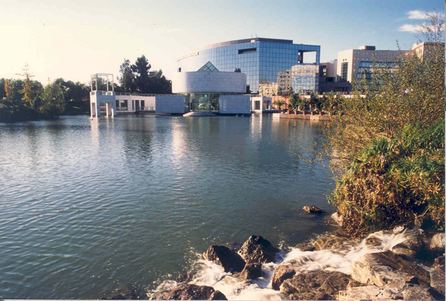The building
The Département des Alpes-Maritimes commissioned the renowned Japanese architect Kenzo Tange to design a building that would be used as a museum and a meeting place for exchanges between the Asian arts and Western culture.
It's originality
Set amongst the many fragrances and lush vegetation, the Asian Arts museum is built on the lake of the park, giving the illusion of floating on the water. The museum’s design is based on the contrast between the solid shapes and the transparent walls. The white marble covering the walls of the museum gives it an appearance of robustness, while the glass panels give it lightness. The volumes are clearly separated by linear openings giving the impression that the architecture is playing with the laws of gravity.
A place, the art works. The coherence of the architecture is extrapolated in the route followed by visitors.
In my mind the museum is a snow coloured jewel shining in the blue of the Mediterranean. It is a swan floating on a tranquil lake surrounded by lush vegetation... Kenzo Tange
Based on a selection of iconic works evoking Asian cultures, combining court arts with popular and tribal expression, the museum's collection reconciles genres that have traditionally been split between history, ethnography and decorative arts museums, while also including some more contemporary art.
Among the collections, various live art performances, demonstrations of Asian culture and weekly tea ceremonies extend the pleasures of visiting this serene building.
Architecture
The four cubes evoke the two mother civilizations of China and India and their dissemination to Japan and Southeast Asia.
On the first floor, the rotunda topped by a glass pyramid is reserved for the spiritual sphere of Buddhism.
The basement is reserved for simple materials found in more familiar surroundings (housing, furniture, textiles and ornaments), located together near the multimedia area, on the theme of tradition and modernity.
With these collections of ancient pieces the museum emphasizes the continuity of Asian tradition and know-how. The ground floor is home to the museum’s four geographic zones.
The museum display
The museum display, designed by the architect François Deslaugiers, is completely in tune with the concept of highlighting the value of the object. Along with fine-tuned lighting, it makes use of glass display systems that disappear, and marble, metal and glass structural materials that do nothing to distract the eye. Each room is unique, magically appearing in the light.
The tea ceremony has led to greater refinement, not only in the techniques for growing tea plants, but in all the techniques involved in the manufacture of the objects used in the ceremony, and consequently has made an important contribution to the development of arts and crafts.






